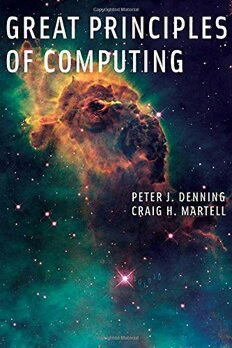
Great Principles of Computing PDF
Preview Great Principles of Computing
Great Principles of Computing Great Principles of Computing Peter J. Denning and Craig H. Martell The MIT Press Cambridge, Massachusetts London, England © 2015 Massachusetts Institute of Technology All rights reserved. No part of this book may be reproduced in any form by any electronic or mechanical means (including photocopying, recording, or information storage and retrieval) without permission in writing from the publisher. MIT Press books may be purchased at special quantity discounts for business or sales promotional use. For information, please email [email protected]. This book was set in Stone Sans Std and Stone Serif Std by Toppan Best-set Premedia Limited, Hong Kong. Printed and bound in the United States of America. Library of Congress Cataloging-in-Publication Data Denning, Peter J., 1942 – Great principles of computing / Peter J. Denning and Craig H. Martell. pages cm Includes bibliographical references and index. ISBN 978-0-262-52712-5 (pbk. : alk. paper) 1. Computer science. I. Martell, Craig H., 1965 – II. Title. QA76.D3483 2015 004 — dc23 2014022598 10 9 8 7 6 5 4 3 2 1 To Dorothy, Anne, and Diana To Chaliya and Katie Contents Foreword by Vint Cerf ix Preface xiii 1 Computing 1 2 Domains 19 3 Information 35 4 Machines 59 5 Programming 83 6 Computation 99 7 Memory 123 8 Parallelism 149 9 Queueing 171 10 Design 195 11 Networking 219 12 Afterword 241 Summary of This Book 249 Notes 257 References 271 Index 287 Foreword Peter Denning and Craig Martell have taken on a monumental topic: iden- tifying and elucidating principles that shape and inform the process of coercing computers to do what we w ant them to do and struggling with the difference between what they a ctually do (that is, what we told them) and what we want them to do. Bugs (errors) are examples of the difference. Bugs are usually a result of inadvertently programming the machine to do something we did not intend. But errors are not the only source of bugs. A bug also arises when an unexpected behavior emerges from the execution of a program in a system. Networks of computers with their myriad variations in software and interactions are often the source of emer- gent behaviors. We sometimes speak of a n etwork effect in which a trend becomes a predominant behavior that reinforces the emergence of some feature that might not have been envisioned or even intended. This can happen when an application is put to use in ways that were not anticipated. Spam and p hishing are examples of emergent behaviors with email in large networks. Such effects challenge our ability to understand, anticipate, and analyze complex behaviors arising in large-scale software systems in large-scale net- works. Even if each component operates within its design parameters, the system as a whole can give indeterminate results because of unpredictable interactions among components. Complex emergent behaviors also arise simply because computing machines are finite. Digitized information always contains small errors of representation. Tiny errors can accumulate into catastrophes over billions of computational steps. A very concrete example of unanticipated results arises from floating point arithmetic with finite precision. Round-off errors and other artifacts of handling very large or very small values can lead to catastrophic results, as William Kahan eloquently demonstrated in his paper on this topic in a symposium on numerical computation in 2005. 1
